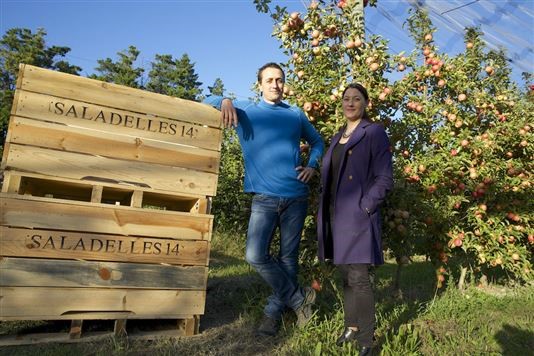loveFOOD meets… a Pink Lady apple farmer

We chat to David Marchetti Galliano, who tells us about the history of his Pink Lady orchard in the south of France.
David Marchetti Galliano took over the running of his family’s orchard in 2002. Originally, the land was bought by his grandfather, who moved to France with the intention of planting vines. David’s father ran the operation from 1970 onwards, and planted the first apple trees on the site in 1980.
Located between Avignon and Lunel in the south of France, the orchard is in the perfect place to grow Pink Lady apples. That's because they require a great amount of sunlight to mature their sweet flavours and the soil, in the Rhône alluvial, is well-suited for growing apples.
A day on the farm
“The apples,” says David, “are picked by hand three times [per growing season] while other apples are picked just once or twice. The most colourful and mature fruits are removed with each round of picking.” But it’s not just a case of identifying the best fruit by eye.
“A starch test is performed to verify the maturity of the fruit,” he continues, as each apple “must meet a set of very specific criteria.” Aside from testing the crop to ensure its suitability, the apples also have to be handled delicately to avoid damage.

David introduced modernised packaging methods when he took over the farm, but says that “we handle them with the utmost care, which slows our packaging between 20-30% compared to other lines.” The apples are picked by hand to “avoid any shock due to clumsy handling”, which ensures that apples reach the market in perfect condition.
At the beginning of the growing season, the soil and trees are given plenty of attention so that everything is in place for the harvest to come. The farm also needs to be protected from pests. David explains that natural methods are used, such as introducing predators to keep the pest numbers down.
Great growing weather
In France, Pink Lady apples are mostly grown in the south east, south west and the Loire Valley, where the climate is “perfect”. This variety is the first to blossom on the tree, but it is harvested very late in the year, during late October and early November.
The three picks of the crop are therefore spread over a longer period, and the apples remain on the tree for a long time. The additional time “enables Pink Lady apples to develop their famous pink blush, crunch, juiciness and their sweeter taste.” They do, however, require “constant attention throughout” their maturation.
And here’s an interesting fact: did you know that to develop their pink colour, the fruit needs to experience a temperature difference of at least 10°C during the day?

Consistency
Producers of Pink Lady apples throughout the world have to follow the same rules of quality control for the sake of consistency “in the intensity of their colour, their sugar content and their firmness.”
They’re good for cooking with, as they need little or no sugar thanks to their natural sweetness – quite the opposite of the sour Bramley. We’ve got a few recipes that call for Pink Lady apples to be used, including this chicken, Fenland celery and apple stir fry, and these spiced beetroot and apple muffins.
The “balance between sugar and acidity lends itself wonderfully to cooking,” comments David, and the apple has become a “favourite of local chefs.”
Are you a fan of Pink Lady apples, for cooking or eating? How do they rate against other varieties? Let us know your thoughts in the Comments below.
You might also like:
loveFOOD meets... a cave-maturing, carbon-neutral cheesemaker
Comments
Be the first to comment
Do you want to comment on this article? You need to be signed in for this feature